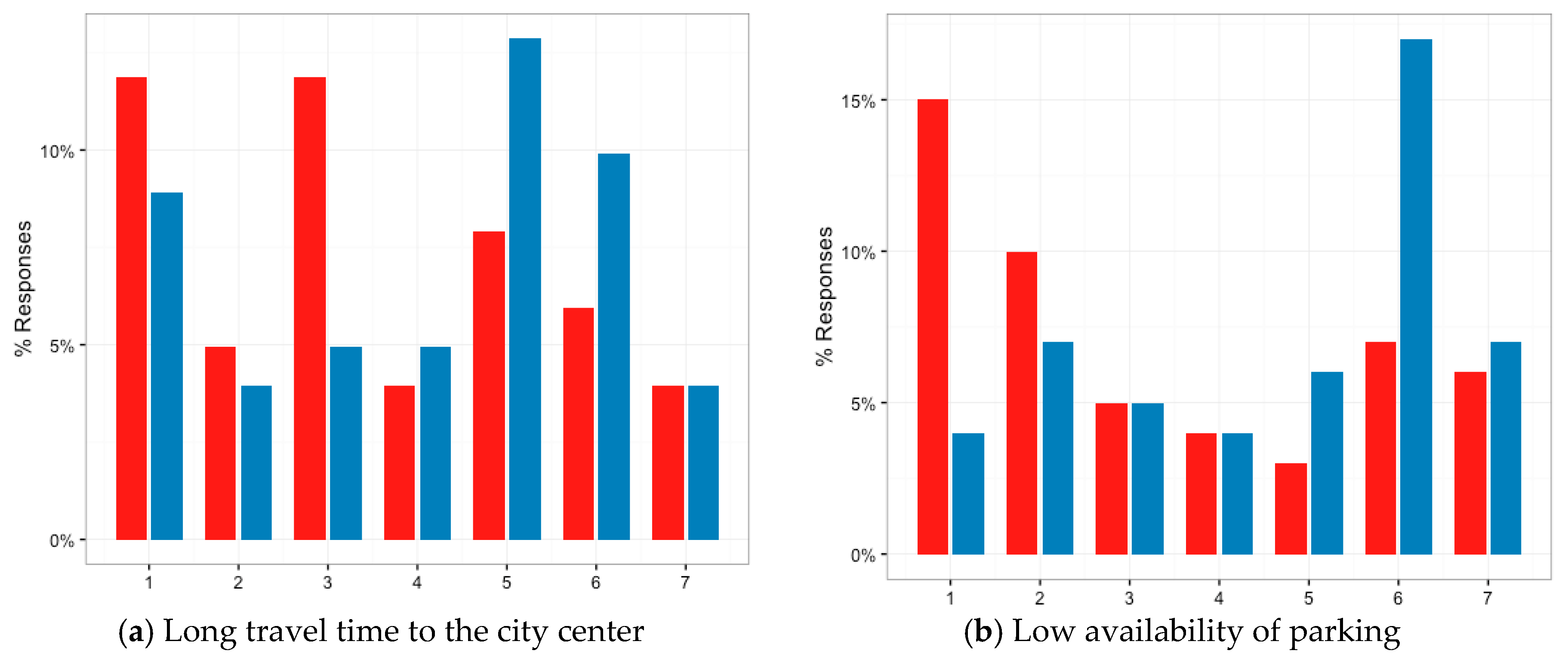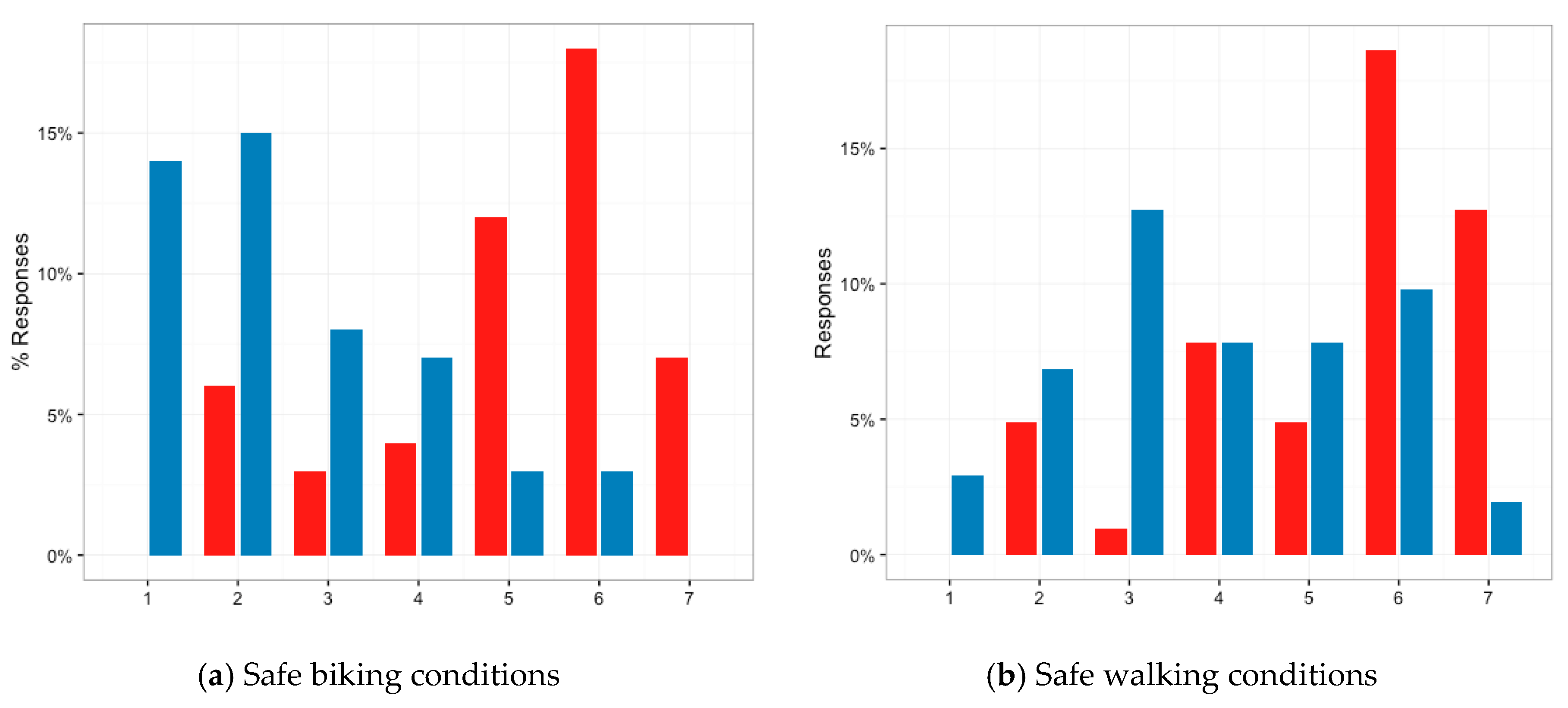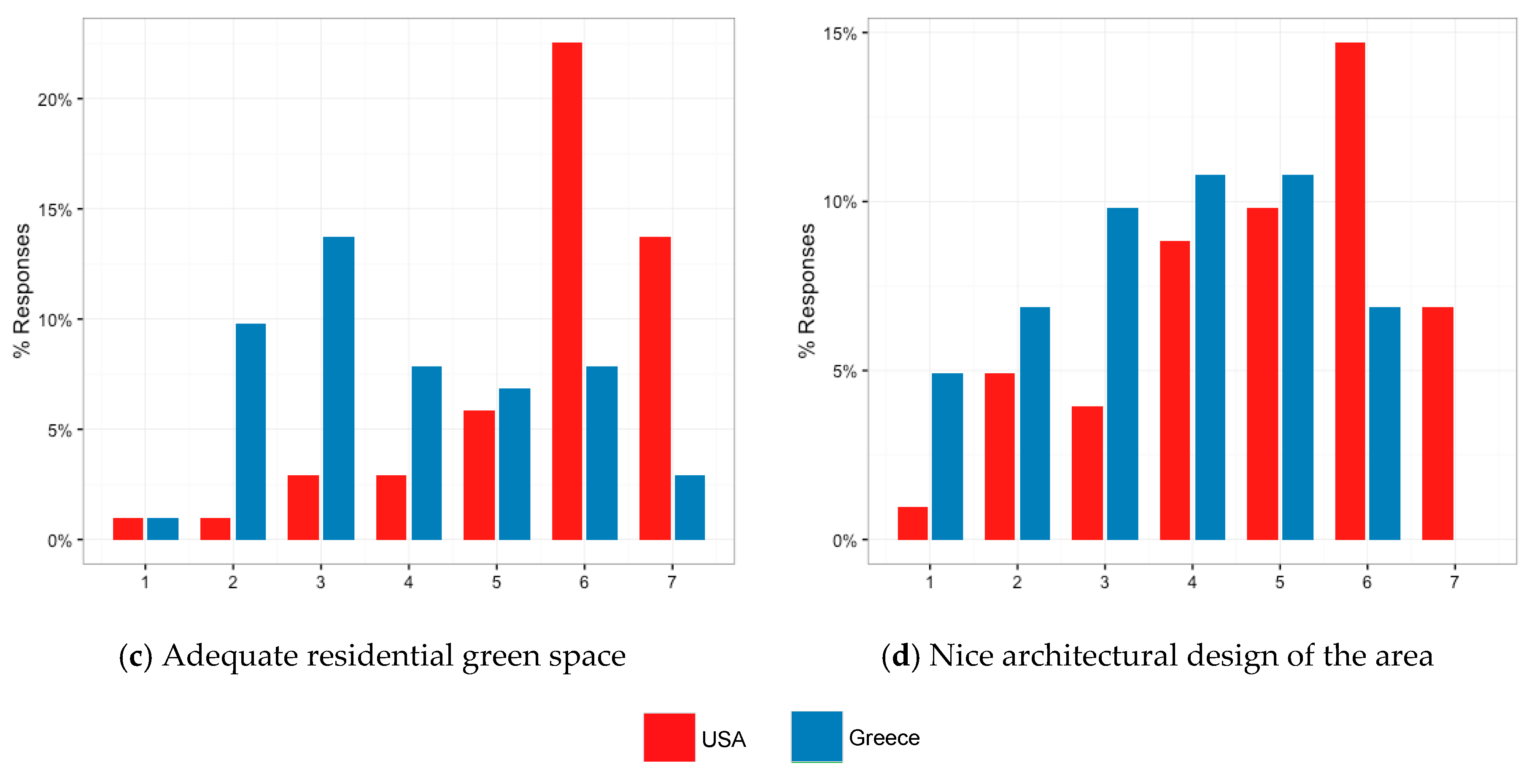1. Introduction
Reducing road transport externalities such as greenhouse gases emissions, air pollution at local and regional level, energy consumption and creating social inclusive, healthy cities remain at the center of the debate for more sustainable urban futures [
1]. Planning for compact, transit-oriented, bicycle and pedestrian-friendly urban forms is considered as an effective way to shorten travel distances and increase use of alternative modes of transport [
2]. However, although numerous studies have shown that urban form characteristics can affect travel behaviour (see [
3] for a detailed review of these studies), self-selection, namely the causality in this relationship remains unresolved [
4,
5,
6]. Hence, the effectiveness of the respective planning policies in promoting sustainable mobility could be lower than expected, albeit arguments that attitude induced self-selection cannot influence neither the causal mechanism, nor empirical estimates of the built environment and travel behaviour relationship exist as well (see [
7] and the subsequent very interesting discussion: [
8,
9]).
Thus far, several approaches have been applied to address self-selection with mixed results. According to Cao et al. [
5] longitudinal or quasi-longitudinal designs can improve causality inferences, controlling for attitudes and any other variables that do not change over time. However, quasi-longitudinal studies have restricted their focus on residential relocation within the same region (see e.g., [
10,
11,
12]). Hence, the extent of movers’ exposure to different built environments is possibly quite limited and consequently the ‘treatment’ dose may be quite low. This in turn may lead to an underestimation of the built environment effects on travel behaviour in comparison to self-selection effects.
The objective of this research is to investigate the possible causal relationships between the built environment, travel behaviour and travel attitudes of people that have moved between totally different urban and transportation contexts. To this end, a questionnaire survey was conducted among people who had relocated from the US to Greece within the last eight years before the survey, having also lived for more than a year in the US. The results of the survey were analyzed through a combination of non-parametric tests, factor analysis and linear regression modeling. The rest of the paper is structured as follows: the literature review is presented after the introduction (
Section 2), and a description of data collection and modeling methodologies follows (
Section 3). Finally, results of the analysis (
Section 4) and conclusions (
Section 5) are subsequently presented.
2. Literature Review
Several approaches have been used to address the attitude-induced self-selection bias in the relationship between the built environment and travel behaviour [
4,
5]. Here, we focus on longitudinal research designs. Longitudinal designs that control for attitudes have been suggested as a powerful approach to explore causal relationships between the built environment and travel behaviour for two main reasons: first, they account for the confounding influence of self-selection and second they fulfill the time-precedence criterion for causal inference.
In the US context, Krizek [
10] focused on households who relocated within Central Puget Sound region. He explored the effects of neighbourhood accessibility changes on travel behaviour after controlling for socio-demographic characteristics, regional accessibility and workplace accessibility. Approximately 20% of the households in his sample relocated close to their initial location (less than 2.5 miles). He employed linear regression models and found that households moving to neighbourhoods with higher accessibility tend to reduce vehicle use in terms of vehicle-kilometers traveled (VKT). Handy et al. [
11,
13] focused on recent movers in eight neighbourhoods in Northern California. The selected neighbourhoods varied systematically according to the neighbourhood type, size of the metropolitan area and region of state. Both studies employed a quasi-longitudinal design, asking the movers to respond about potential changes in driving, walking and cycling behaviour and about their perceived characteristics of their current and previous neighbourhood. Results from ordered probit models showed that change in accessibility was the most influential factor for driving and walking after controlling for attitudes and socio-demographic characteristics. Built environment variables were also significant in the model for cycling, but the pro-bike/walk attitudinal factor was the most influential factor in this model. Moreover, Cao et al. [
14] using the same dataset showed that built environment characteristics like perceived outdoor spaciousness (e.g., large yards and off-street parking) influence auto-ownership after accounting for attitudes.
In the European context, Aditjandra et al. [
12] employed a quasi-longitudinal research design, similar to Handy et al. [
10], to examine the relationships between the built environment, neighbourhood preferences, travel attitudes and travel behaviour in the UK. Their sample comprised 219 movers who had relocated to ten neighbourhoods at Tyne and Wear metropolitan area in the North East of England within eight years before the survey. Their structural equation model (SEM) showed that neighbourhood characteristics (safety factors and shopping accessibility) do affect driving behaviour after controlling for self-selection. They also concluded that the size of the neighbourhood characteristics effect on driving behaviour is consistent with the respective effect identified by Cao et al. [
14] in the US context. Schneiner and Holz-Rau [
15] focused their research on 791 movers who had relocated to ten study areas in the Cologne region within 14 years before the survey. The study areas represented five neighbourhood types ranging from central high-density to typical suburban neighbourhoods. The change of built environment type (from suburban to urban/inner city and vice versa) was captured by an ordinal variable. The SEMs showed that built environment changes were associated with significant changes in travel mode use. Specifically a residential move to a more suburban environment was found to induce more car trips and less public transport use, bicycle use and walking. Klinger and Lanzendorf [
16] explored the impacts of urban form (i.e., neighbourhood type and activity spaces), residential preferences and the perception of urban mobility cultures (reflecting transport supply, travel-related attitudes and urban-level transport policy) on changes in car, rail transit and bicycle use of 1450 long-distance movers who had relocated up to five year before the study between the regions of Bremen, Hamburg and the Ruhr area. Their multiple regression analyses showed that local spatial characteristics along with socio-demographics have significant impacts on levels of car use, while metropolitan-scale features expressed by the urban mobility cultures factor mainly influenced levels of cycling. Preferences towards residential choice were found to be associated more with changes in car and rail transit use and much less with changes in cycling. Meurs and Haaijer [
17] explored whether changes in spatial and personal characteristics for movers in the Netherlands were associated with travel behaviour changes in terms of number of car, bicycle, walking, public transport and total trips. They used data for 189 movers from the Dutch Time Use Study at two time points: 1990 and 1999. The regression analyses results showed that spatial characteristics do influence travel behaviour (e.g., moving to a pedestrian-priority neighbourhood was associated with less car trips). Changes in employment or car ownership were found to have major impacts on the number of car trips as well.
In the Australian context, Giles-Corti et al. [
18] surveyed 1420 persons before and after relocation (12 months later) to their newly built homes in the city of Perth, Australia. They explored the impacts of objective and perceived neighbourhood characteristics, on changes of both transport and recreational-related walking controlling for intrapersonal (e.g., attitudes towards trying to walk locally), interpersonal (e.g., frequency of social support from family and friends) and reasons for residential location choice (e.g., ease of cycling, walking). These researchers run generalised linear mixed models and found that increased access and diversity of local transport (e.g., post offices, bus stops, delicatessens and supermarkets) and recreational (e.g., beaches, parks, sports fields) destinations had a positive impact on walking levels. This study found no evidence of impacts on walking levels from self-section towards residential choice.
Finally, several studies employed panel data to explore relationships between built environment and travel behaviour, controlling for self-selection. Kamruzzaman et al. [
19] measured changes of socio-demographics, urban form, travel attitudes, living preferences and transport-related walking time of 3708 individuals in Brisbane Australia between 2009 and 2011. According to the results of their linear regression model, changes in urban form (increased density, better street connectivity and access to train) were associated with increased walking levels. Travel attitudes and perceptions (e.g., increased perception of car safety), but not living preferences, were also found to exert significant influence on walking behaviour. Van de Coevering et al. [
20] developed a cross-lagged panel structural equation model based on a two-wave longitudinal dataset (2005 and 2012) involving 1322 respondents from three municipalities in the Netherlands (Amersfoort, Veenendaal and Zeewolde) to explore relationships between the built environment, travel-related attitudes and travel behaviour. They found that only one of the accessibility metrics employed in this study (i.e., distance to railway stations) exerted strong and significant negative influence on car use. No evidence of attitude-induced residential self-selection in residential location choices was identified. Yet, built environment appeared to influence travel-related attitudes. Moreover, these researchers concluded that built environment differences in the sample should be quite large before travel behaviour effects can be detected.
Our literature review showed that most frequently, longitudinal designs are applied in the context of residential moves, where travel and built environment data are collected before and after the move. Attitudinal data are typically cross sectional (measured after the move) assuming stability of residential and travel preferences over time. Thus far, most longitudinal studies have focused on residential relocation within the same region limiting the extent of movers’ exposure to different built environments. Consequently the ‘treatment’ dose that the movers receive may be quite low, thus limiting the size of ‘treatment’ effects. Built environment was consistently found to influence changes in travel behaviour across all studies in different continents after accounting for attitude-induced self-selection. In some studies, travel related self-selection towards residential choice was not identified as significant variable for travel behaviour changes.
5. Conclusions
This study explored the possible causal relationships between the built environment, travel attitudes and travel behaviour of people that have relocated between urban and transportation contexts that differ significantly. An electronic questionnaire was designed (based on [
11,
12]) and disseminated on-line to people that currently reside in Greece, but have lived for more than a year in the US during the last eight years before the survey. A sample of 51 responses was collected, and the data were qualitatively and quantitatively analysed using a three-step methodology. Variable reduction techniques were applied prior developing our models because of the small sample size.
Wilcoxon tests’ results showed that accessibility and built environment contexts in which participants of this survey have lived in the US and Greece differ significantly. As we expected, after relocation in Greece respondents typically experienced lower car accessibility at regional level (e.g., more difficult access to central arteries and lower parking availability at usual destinations outside the neighbourhood) and worse conditions for walking and cycling at the neighbourhood level (mainly due to lack of adequate infrastructure, particularly pavements, cycle facilities and open spaces).
Quasi-longitudinal analysis showed that changes in driving, biking and walking are mainly associated with changes in accessibility, car availability and socio-demographic characteristics, but not with travel attitudes or neighbourhood preferences. This result adds to previous evidence linking built environment and car use after accounting for self-selection [
10,
11,
12]. We should however note that in our case the transportation networks component of accessibility seems to play a very important role in changing travel behaviour. In other words, congestion in urban arteries as well as worse conditions of cycling and walking facilities in the Greek context were associated with more driving. Changes in bicycle use and walking between the US and Greece confirmed the importance of the transportation networks component of accessibility for those two modes of transport as well. It seems that in contexts where transport infrastructures are not adequately developed, like Greece, low safety levels for cycling as well as difficulties in public transportation access can influence the extent of bicycle use and walking. According to a recent study, lack of cycling infrastructures is considered by Greeks as one of the main inhibitors of bicycle use especially among women and older age groups [
33]. The built environment component of accessibility was found to be important as well. Longer travel time to city center was associated with higher car use, higher density neighbourhoods and increased accessibility to local amenities were associated with increased bike use and better access to a district shopping center was associated with more walking. The critical role of distance to city center and residential density for travel behaviour in the Greek context has already been identified in an earlier study [
34]. The results of this study indicate the importance of an integrated approach involving sustainable land use policies and development of networks for the alternative modes of transport for reducing car use and promoting cycling and walking.
The authors are aware that there are several limitations that should be taken into consideration in this study. First, the sample profile (mainly students and researchers that have moved from the US to Greece), along with the relatively small sample size, limit the generalizability and the robustness of our results. After this study, a logical next step would involve replication of these methods in a greater scale identifying as population, for example, any person that has moved from the US to a European city. A parallel qualitative in-depth exploration of behavioural changes after returning to a European city would enhance our understanding about residential and travel choice mechanisms. Second, many respondents may have returned to Greece a long time ago, meaning that they may not well remember the conditions of their US neighbourhood. Future research could avoid this limitation by focusing on relocation within shorter period before the survey (e.g., five instead of eight years). The expansion of geographical area of the study (i.e., relocation from the US to any European city) would allow easier collection of such sample. Also, respondents’ attitudes in this study are assumed to be constant before and after relocation, which simply may not be the case. This is an inherent limitation of the quasi-longitudinal approach. However, attitudes changes might partly cause the decision to relocate and therefore to account for some of the built environment effects on travel behaviour (see [
5]). Measurement of respondents travel attitudes before and after relocation in a true panel study would solve this problem (see [
11]). Finally, perception of accessibility and built environment characteristics may not reflect the objective reality of respondents’ neighbourhood characteristics [
35,
36], which may restrict the usefulness of our results with respect to policy implications. Therefore, we recommend that studies also involve objective measures of accessibility and built environment characteristics in their analysis. We should note though that there is a tradeoff between the level of geographical dispersion of the sample, and the ability to measure accessibility and built environment contexts of the participants’ neighbourhoods.
In conclusion, the results of our study add evidence to the existing literature identifying a causal relationship between the built environment and car use after accounting for travel attitudes. What this study reminds us, though, is that accessibility is defined not only by the spatial allocation of destinations (i.e., the built environment), but also by the transportation networks. Thus, any policies aiming to reduce car use and especially promote walking and cycling may first make sure that adequate transportation networks are developed.











